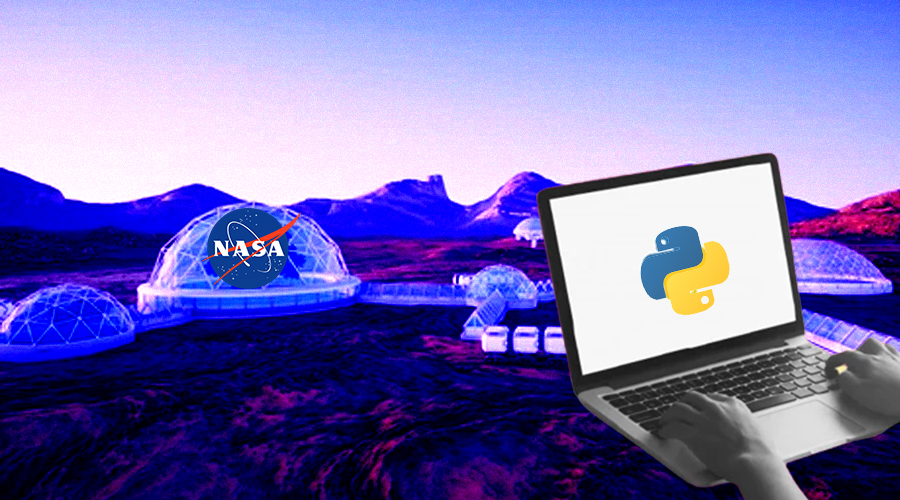Mahindra Lifespaces unveils India’s first home buying experience on the Metaverse
SOURCE: HTTPS://INDIATECHNOLOGYNEWS.IN/
OCT 31, 2023
CAN PYTHON HELP CREATE THE MARTIAN METAVERSE THAT NASA IS LOOKING FOR
SOURCE: ANALYTICSINSIGHT.NET
MAY 28, 2022

NASA, the US space agency, has partnered with Epic Games, the company behind Fortnite, to build a challenge for developers to help create a Martian metaverse experience. The challenge will include various tasks, including designing several key environments for Martian astronauts, which will be rendered using Epic Games’ Unreal Engine 5 to provide a realistic environment. As you know python is one of the most popular programming languages in the world but is less widely used in the game development world. However, it’s a good starting point for new developers. So, when this partnership was announced many people had this question: Can Python help create the Martian metaverse that NASA is looking for? Let’s find out the answer.
NASA to Develop Martian Metaverse to Help in Training Exercises
NASA, the US space agency, has recently posted a challenge to attract developers to help build a Martian metaverse environment to aid in training. The challenge, which was posted in Herox, a crowdsourcing problem-solving platform, calls for developers to aid the institution in building “Virtual Reality (XR) assets and scenarios for use by NASA in research focused on extravehicular activities on the surface of Mars.”
The challenge aims to populate an already-started metaverse world called MarsXR, which has now mapped 400 km2 of Mars terrain, with realistic day/night cycles, all modelled with Epic Games’ Unreal Engine 5, which will also be used by the developers to create the submissions in the challenge.
Python in the Metaverse
Python first came onto the software development scene around 30 years ago and is to this day widely used as a popular general-purpose coding language. Being an open-source language means that you have a vast global community of developers, enthusiasts, and corporations using and helping to further develop it, which means there is both plenties of support available and it is future-proofed.
Python’s open-source nature can be a double-edged blade because of the inherent security risks that come with a free-to-use coding language. Nevertheless, Python is absolutely essential for modern programmers, especially those who are interested in building virtual reality applications. Python is also used for building augmented reality solutions.
The challenge seeks to achieve the following goals:
The challenge will involve developers to create new assets and perform tasks like designing essential environments for Martian astronauts. This would mean developing Mars XR Operations Support System (XOSS) environment, using Epic Games’ Unreal Engine 5.
The challenge will include various tasks, including designing several key environments for Martian astronauts, which will be rendered using Epic Games’ Unreal Engine 5 to provide a realistic environment.
It calls for developers who can facilitate NASA in building Virtual Reality (XR) assets and scenarios.
These will be used by NASA in research focused on extravehicular activities (EVAs) on the surface of Mars that will be used to check procedures and plan for conditions while on Mars.
The goal is to create an immersive, engaging, and realistic experience.
But as Martian metaverse will be made in the Unreal 4 engine, the code used for the game in C++. They have used blueprints as well, but blueprints are basically just fancy-looking C++ code blocks, so that makes it C++ as well. As for the visual side of things (shaders), Unreal 4 mainly uses HLSL. C++ is an excellent programming language for game development. Its low-level language components give you the freedom to manipulate hardware and ensure a highly responsive gaming experience. While higher-level languages are faster to write in, they don’t give you the flexibility and performance that C++ provides.
LATEST NEWS
Augmented Reality
Hi-tech smart glasses connecting rural and remote aged care residents to clinicians
NOV 20, 2023
WHAT'S TRENDING


Data Science
5 Imaginative Data Science Projects That Can Make Your Portfolio Stand Out
OCT 05, 2022

SOURCE: HTTPS://INDIATECHNOLOGYNEWS.IN/
OCT 31, 2023
SOURCE: HTTPS://FINANCE.YAHOO.COM/
SEP 28, 2023
SOURCE: HTTPS://MEDIABRIEF.COM/
SEP 22, 2023
SOURCE: HTTPS://WWW.BUSINESS-STANDARD.COM/INDIA-NEWS/METAVERSE-WEB3-MARKET-TO-GROW-40-ANNUALLY-TO-REACH-200-BN-BY-2035-123060200394_1.HTML
JUN 28, 2023
SOURCE: HTTPS://WWW.WIRED.COM/STORY/WHAT-IS-THE-METAVERSE/
JUN 20, 2023